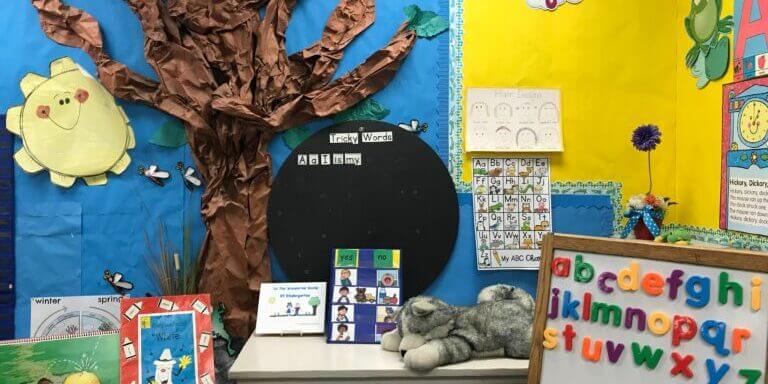The days leading up to the first day of school are chaotic for everyone involved. Students are excited to see their friends again and get to know a new class while teachers are putting the finishing touches on lesson plans and classroom themes. Even veteran educators can still feel “First Day of School Jitters” in the days leading up to the start of the year. Take a deep breath. You have everything under control and will be more than prepared for the first day. Follow this back-to-school checklist for teachers to make sure your classroom is all set up for the new year.
Establish Classroom Management Policies
- Review your classroom rules. Check to see if anything needs to be added or modified ahead of the new school year. If you are a new teacher, develop a list of concrete rules your students need to follow (and your substitutes can enforce).
- Develop consequences if students break your rules. Prepare to clearly communicate these on the first day and place a sign with the rules on the wall.
- Find your bathroom passes or create new ones. Update them ahead of the year if you need to.
- Learn where your students will be sitting in the cafeteria so you can easily navigate the tables on the first day.
- Identify classroom roles and jobs that you need to establish. Determine how you assign these roles and how they change. For example, each day there could be a new line leader working alphabetically down the roster.
- Create a substitute folder. This should include everything another teacher needs to run your class for a day or more. Here is a useful guide and template for this folder.
- Create an absentee folder. How can students pick up assignments they missed when they are absent?
Organize Your Classroom
- Choose a classroom theme if you typically have one. Brainstorm different ways to decorate your classroom and stick to the theme throughout the year. For example, if you are putting together an outer space theme, each group of desks can be named after a different planet.
- Decorate your front door. This is the first impression your students will have of your classroom.
- Decide how you want to set up your desks. Do you want your students to sit in groups or in rows? How will you assign seats?
- Create place settings for your students at their assigned desks. This way you can learn who the students are and your learners can quickly find their assigned seats on the first day.
- Identify any special areas you want for your class. Will you have a reading rug that students can sit around? Will you have a quiet corner for students who get overwhelmed?
- Make sure you can see everything from your desk. You don’t want students hiding from you in different corners.
Review and Invest in the Right Technology
- Decide what media you want to keep up with this year. Do you have a class website? What about a Facebook page? Some teachers even post on Instagram and TikTok to keep parents informed.
- Get to know any new schoolwide media that you will be expected to use this year. These systems could range from new grade book apps to clearer lesson plan tools.
- Identify any subscriptions you have and see if they have expired or are about to expire. Choose which subscriptions you want to keep and which ones you can cancel.
- Choose which edTech tools you want to use throughout the year. Spend time logging onto these apps and navigating them on your own. Ask for help if you get stuck trying to use them. (Hint: now is a great time to try eSpark!)
- Decide which systems parents will have access to. Make sure there are parent-side and student-side portals that are easy to access. Develop instructions on how to access these portals and set up parent accounts.
Meet With Your Colleagues
- Introduce yourself to any new teachers in your grade. If you are new, spend time introducing yourself to other teachers who you will be working with.
- Visit the gym, arts, music, and drama teachers, along with other educators who your students will meet with (technology teachers, librarians, etc.). Reconnect with these educators if you already know them and introduce yourself if they are new. You both will need to work together throughout the year.
- Meet with your principal ahead of the year. Ask if they have any professional development goals for you.
- Check with your admin team and principal to see if there are any committees you want to join. The fundraising committee or DEI group might welcome your insight.
Collect and Organize Supplies
- Sort through all of your school supplies and resources in your classroom. Identify which school supplies can be reused ahead of this school year. Keep an inventory of the supplies you have and those you acquire.
- Throw out supplies you can no longer use. These include markers that are dried out or magazines that are too cut up for art projects. Add items that you throw away to your classroom wishlist.
- Develop a donations list of items you wish parents would contribute to your classroom. These can range from small items like pencils to financial contributions for larger investments (like drones, reading nooks, and digital whiteboards).
- Label all of your supplies with your name and grade. This prevents students and other teachers from walking off with them.
- Stamp any books you bring into the classroom with your name, grade, and school. This way the books won’t get sent to the library or taken by students. Organize these books on your shelves.
- Set a budget for yourself. Teachers often have to spend their own money on supplies. Decide on a ceiling for what you can spend and find an accountability partner to help you stick to it.
- Check the status of any grants you applied for over the summer. Look into new grants you can apply to in order to fund your classroom.
Get Used to the New Schedule
- Check to see if there are any changes to this year’s bell schedule. Is school starting earlier? Are the classroom periods adjusted?
- Get to know your specific classroom schedule. Familiarize yourself with your lunch periods, planning time, and the different electives your students will attend. You don’t want to get mixed up during the first week.
- Spend time reviewing emergency procedures. What happens if there is a fire drill or tornado drill? If you are in a new classroom, walk the path for a fire drill to make sure you lead your students to the right spot.
- See if you have any before or after school responsibilities coming up. You may need to manage the carpool lane or receive students from buses early in the morning this week.
- Block out important events in the coming weeks. Mark parent-teacher conferences, PTA meetings, and teacher training days on your personal and professional schedule.
Gather Your Lesson Plans
- Identify useful resources that you can laminate and use throughout the year. These range from flashcards of math symbols to red, green, and yellow signs to manage your classroom.
- Organize your supplies so you can easily access key materials when starting lesson plans. You don’t want to spend your planning period digging through your cabinets.
- Review your lesson plans for the first week. Do you have all of the materials you need? Do you know where they all are?
- Go over any summer assignments that students had to complete – especially if they were sent out across the grade. Decide how to evaluate these assignments for completion and understanding.
- Create a folder of backup lessons if you need to fill extra time. It’s better to have a video or game planned ahead of time than to scramble when you need it.
Get Ready for the First Day
- Look up some first day of school activities to welcome your kids to class. These can include games to get to know your class and crafts to personalize each student’s desk area.
- Review the names of your students. Look up the pronunciation of any difficult names or ask other educators who have taught those students before. Many kids are used to having their names mispronounced, so saying them correctly can delight your students.
- Ask teachers in the grade below about your students. While you want to give each student a fair chance and approach your class with an open mind, it might help to understand the unique situations of some learners.
- Prepare a tour of the school for your students. Consider the different locations they need to know (bathroom, clinic, media center, gym, cafeteria, carpool lane, etc.) and develop a plan to visit all of these places.
- Make all of the copies you need for the week. The copier might be in high demand for the first few days and you can’t leave your class unattended to create documents. Take advantage of the quiet days before school officially starts.
Start Building Your Parent-Teacher Relationships
- Create a welcome video introducing yourself to parents. Show them the classroom and talk about your goals for the year. If you have a multilingual classroom, consider working with a translator (if you aren’t bilingual) to create multiple versions of the video. You can also provide a transcript for easy translation.
- Write your first welcome email. Connect with parents and let them know everything they need ahead of the first day. You can include your welcome video in this message along with your wishlist.
- If you are active on social media in a professional capacity, make sure the parents know how to reach you. For example, if you create a class Facebook group, see which parents have already joined.
- Create a list of roles for parent volunteers along with a sign-up sheet. This will give you an idea of how much help you need and how many parents are interested in helping. Allow parents to sign up for specific tasks that interest them. Not every parent wants to chaperone a field trip so create multiple ways to help.
- Decide how you will update parents on student progress throughout the year. Clearly communicate when parents will be updated on their students and how.
- Set boundaries for when you will not answer texts or emails from parents and students. Clearly communicate these hours with everyone involved. For example, you can develop a “no emails after 8:00 PM” policy so parents know not to expect replies at night.
Bonus: Celebrate the new school year the weekend before. Enjoy a nice dinner out or fun weekend activity. Your kids are saying goodbye to summer and you can too!
Add Trying eSpark to the Back-to-School Checklist for Teachers
This back-to-school to-do list for teachers is meant to help you organize your thoughts and create a plan of action for the next few days before the students arrive. You might need to spend more time on some areas than others. However, spend some time getting to know the tools that can help you enhance your lesson plans. Try eSpark for free today. We have an intuitive system that is easy for teachers and students to navigate. Our program might become your new favorite learning system for your classroom.



